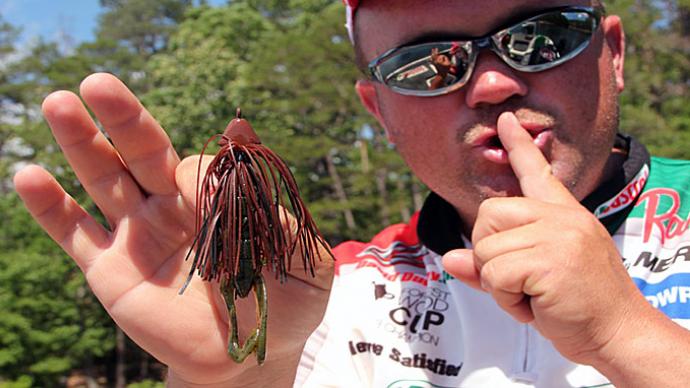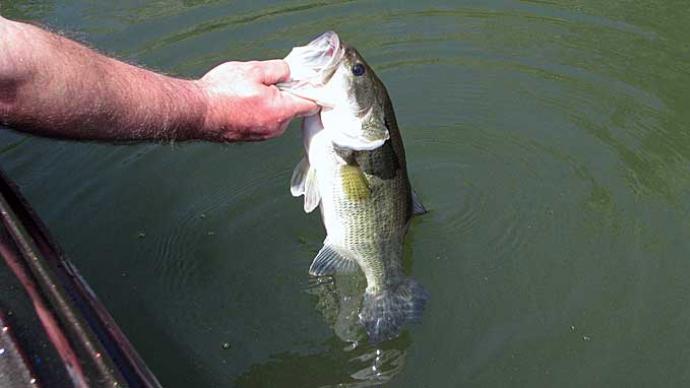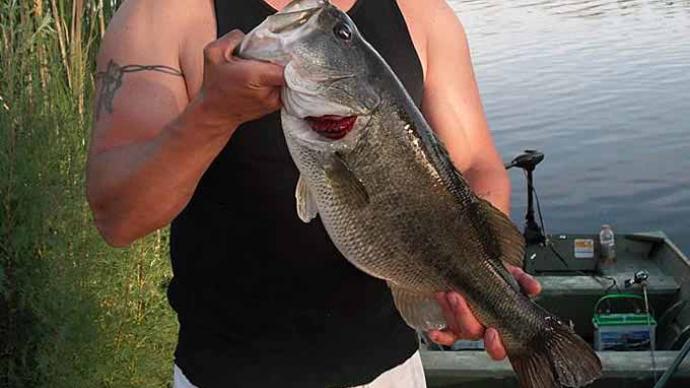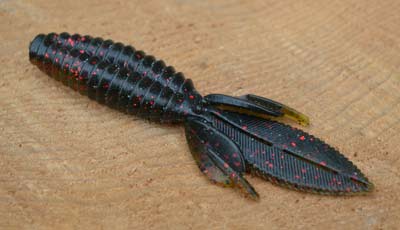
The creature-bait universe is home to several subsets of soft plastics. There are gill-, hawg- and insect-style baits. Some anglers throw spider grubs into the mix. But there’s one that you’ll want to rig when the calendar reads July, and that’s beaver-style creatures. The original and best-known is Reaction Innovations’ Sweet Beaver, which lent its name to the category.
The Sweet Beaver hit the market in the early 2000s when its inventor, Andre Moore, used it to win two FLW Tour events on Beaver Lake in Arkansas. Since then, bass anglers have caught countless bass with it. That popularity pushed other soft-plastic lure manufacturers to make versions, including Strike King’s Rage Bug, Berkley’s PowerBait MaxScent Creature Hawg, and Zoom's Z Hog.
While each beaver-style bait has its own personality, there are three core traits that the best ones share:
- Flat body: While most have ribs or bumps, the body is always wider than it is thick. There’s plenty of surface to act like a parachute. That causes the bait to glide like a tube bait rigged on an internal jig head, creating more action than a bait that sinks straight to the bottom.
- Moveable appendages: These serve two purposes. If they’re large and flat, they can add glide to the bait. If they’re thin and curled or tipped with kickers, they add action, not only when sinking but also when resting on the bottom. The body may be still, but these are waving.
- Salt or scent: Additives make your beaver-style bait more attractive to bass. While bass may strike occasionally because of the scent, it and salt more often encourage bass to hold your bait longer after they strike, giving you more time to set the hook. That’s important when a bass bites on slack line.
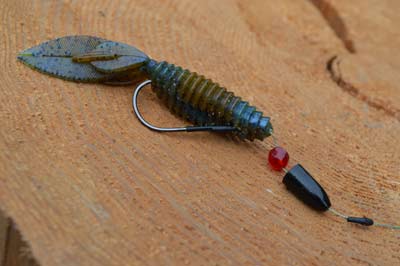
The wide variety of beaver-style baits makes it easy to find a match for current fishing conditions, whether that’s a finesse-sized one sporting a natural hue for clear water after a cold front or a large dark-colored one with kicking tails for bass tucked in heavy cover that’s surrounded by murky water. And while they can play many roles, including as a jig trailer, they’re best on their own in summer.
You can go in two directions to fish a beaver-style bait during July. Both are productive, but each requires its own approach, tackle, and presentations. The one you choose depends on the water you're fishing and how its bass behave. Here's how to tackle both.
1. Go shallow
Shallow water and bass fishing go together like peanut butter and jelly. July is one of the best months to fish shallow. On Northern rivers and natural lakes, aquatic vegetation is in full bloom, creating plenty of cover for largemouth and smallmouth bass. In many Southern reservoirs, typical summer conditions, such as low inflows, are squeezing the last bits of oxygen from deeper water, forcing bass shallow.
Beaver-style baits are built for shallow-water fishing. Their compact profile mimics the panfish and crawfish, constituting most of a shallow-water bass's diet. Their gliding action brings a bit of horizontal movement, adding strike-zone time in skinny water. That gives bass more time to find and eat your offering.
Getting to these bass, holed up in, under, and around natural and manmade cover, requires pinpoint presentations. So, it’s time to put your pitching and flipping skills to work. Here’s the gear you’ll want:
- Rod: It should measure between 7- and 8-feet long. Lean on its heavy power to wrestle big bass from heavy cover. And choose a fast action, which will improve casting accuracy. But you don’t want it too fast; some give in the tip will ensure your bait lands on target every time.
- Reel: Find one that fits comfortably in your hand. It should have a speedy gear ratio — at least 7:1 — pulling your bait quickly from unproductive water so you spend more time sending it to productive spots. Its shallow spool should spin smoothly, making pitching even the lightest baits effortless.
- Line: Don’t mess around with anything other than braided line, anywhere from 30 to 65 pounds test. Its subtleness will make presentations easy. Its lack of stretch creates powerful hooksets. And its durability allows it to cut through cover, bringing lure and bass back to the boat nearly every time.
- Hook: Keep it simple. Start with a deep round bend, which provides enough gap for your bait and a hooked bass. Choose one with an offset at its eye or some form of a keeper to lock in place your lure while it’s going in and out of heavy cover, saving you from wasting time rerigging.
- Weight: Pick one heavy enough to pitch accurately and get your bait to the bottom through cover and depth. Pegging it helps both. Add attraction by slightly moving your peg up the line, then stringing a glass bead between bait and weight. That freedom will create a clacking sound through collisions.
Any shallow-water cover or structure is fair game for a creature bait. July options are at their most varied of the year, so don't dawdle on one. Keep your trolling motor running and your eyes peeled for the next opportunity, whether manmade or natural.
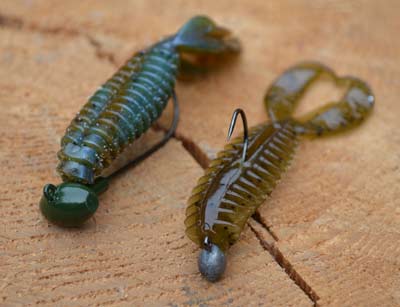
A beaver-style bait rigged Texas style is perfect for aquatic vegetation, regardless of how thick it grows. Use them to probe points and pockets along the edges and openings in the middle of submerged beds. Pitch them into holes in mats or skitter them across the top like a frog. Send one to the base of emergent grass, such as tulles. Allow your bait to soak, giving bass a minute to find it.
There are plenty of bass lakes where grass doesn't grow. And even where it does, manmade cover, including docks, seawalls, and riprap banks, holds its fair share of bass in July. As with aquatic vegetation, focus on the deepest, darkest spots you can find. Pitch as far under a dock as possible, and put your bait tight against seawalls. Watch for bluegill, which spawn around docks, boat houses, laydowns, and other hard cover on summer full moons. They’re a favorite meal of shallow-water bass, and a creature bait perfectly imitates one.
2. Go deep
Shallow water isn’t the only place where you’ll find bass in July. Deep water is where a large bass population spends its summer in many lakes, rivers, and reservoirs. And there are several reasons for that. It could be that there isn’t sufficient cover in shallow water. The water conditions, especially temperature, may be better suited for bass. And sometimes, it's the preference of the species of bass that you're chasing.
Beaver-style baits are as well suited for deep water as shallow water. Their gliding action and compact profile elicit bites here, too. All they need is a change in rigging. They fit perfectly on shaky jig heads, both round and football, and swing heads. And they match with the latest techniques. So, here’s what you’ll want:
- Rod: A casting or spinning rod will work, though the former is better matched to heavier weights. It should measure 7-feet long. Its fast action will launch long casts and create better presentations. And its medium-heavy power will overcome long lengths of line, ensuring better hooksets.
- Reel: Again, choose one with a speedy gear ratio—7:1 or faster—to quickly pull your bait from unproductive water and make more presentations over the course of a day. While a shallow spool can be a breeze to cast, make sure it holds enough line. Depth and casting distance require it.
- Line: Leave your monofilament at home. Fluorocarbon and braided lines will treat you better in deep water. Their lack of stretch keeps you in constant contact with your bait. Start with 10- to 15-pound test fluorocarbon or 15- to 40-pound test braid, choosing stronger versions as cover increases.
- Hook: Although it'll most likely be molded into a jig head, search out super-sharp ones made from medium or light wire. They require less effort to set, an important consideration when your lure is yards away from the boat and feet under it.
- Weight: As in shallow water, you’ll want enough weight to get your bait to the bottom and stay there. Don't go under ¼ ounce, and don't hesitate to push the 1-ounce mark if your spot is extremely deep or buffeted by current. The heavier your lure, the easier it is to feel.
Bass in deep water aren't much different from those swimming in shallow water. They also prefer to be near something different, whether that's cover, structure, or a combination of both. That gives them a place to ambush prey and seek refuge during changing conditions.
Start your search for deep-water bass by looking for structure. It could be a point that tapers into the main lake, a stretch of river-channel ledge, or an underwater hump. Typically, the more vertical that piece of structure, the more likely it'll hold bass in July. Once you've located a piece, look closer for cover such as sunken brush, a shell bed, or a pile of rocks. Aim your casts to these "sweet spots," which always attract more bass than structure on its own. Retrieves are often as simple as dragging your bait across or through the structure and cover.
Beaver-style baits are a well-suited option for mid-strolling, helping you make better use of forward-facing sonar. Rig yours on a jig head that weighs between 1/16 and ¼ ounce, depending on the depth at which you see bass. That relatively light weight and this bait's inherent gliding action will keep your lure at a constant depth with a slow and steady retrieve.


